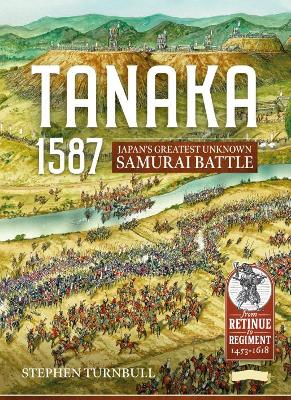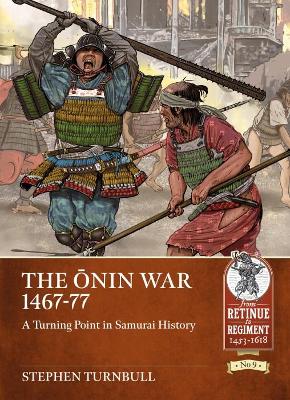Retinue to Regiment
2 total works
In 1587 the 1,000-strong garrison of tiny Tanaka Castle in Higo Province (modern Kumamoto Prefecture) on Japan's southern island of Kyushu, held out for 100 days against an army ten times their size sent by the great general Toyotomi Hideyoshi. When the castle fell it was burned to the ground, and for four centuries the epic struggle lived on only through a handful of letters, two little-known war chronicles and in the folk memories of the local people who continued to make offerings on the now anonymous hillside to comfort the tormented spirits of Tanaka's dead warriors.
In 1986 everything changed. Prompted by the approaching fourth centenary of the battle the local council set in motion a systematic archaeological investigation of the castle site. Many interesting finds were made, but the greatest discovery of all came in 1989 in a distant library when a researcher unearthed what turned out to be Japan's oldest surviving battle map. It featured a detailed drawing of Tanaka Castle during the siege that matched up exactly with the picture that was emerging from the excavation. The unique document also contained so much extra information that, when combined with the archaeological finds, the written materials and local folklore, the almost forgotten siege of Tanaka became one of the best documented battles in the whole of Japan's samurai history.
Tanaka 1587 tells the complete story of the epic struggle for the first time outside Japan by using the evidence that is available from history, literature, folklore, archaeology and cartography. It is based on the author's own translations of the chronicles and the archaeological report together with his extensive fieldwork over a period of many years. The story is presented as an exciting (and sometimes violent) historical narrative illustrated with unique photographs and maps. The contribution of the battle's enshrined spirits to present-day folk religion is also assessed, while attitudes towards the site's conservation, preservation and celebration provide a fascinating insight into how modern Japan views and exploits its samurai history in a society that has had to come to terms with a violent past.
Before 1987 the siege of Tanaka Castle was virtually unknown beyond its immediate boundaries. Just as thirty years of painstaking work and enthusiastic publicity have transformed its status within Japan, this unique ground-breaking book will enable Tanaka's story to be understood and appreciated by a much wider international audience.
In 1986 everything changed. Prompted by the approaching fourth centenary of the battle the local council set in motion a systematic archaeological investigation of the castle site. Many interesting finds were made, but the greatest discovery of all came in 1989 in a distant library when a researcher unearthed what turned out to be Japan's oldest surviving battle map. It featured a detailed drawing of Tanaka Castle during the siege that matched up exactly with the picture that was emerging from the excavation. The unique document also contained so much extra information that, when combined with the archaeological finds, the written materials and local folklore, the almost forgotten siege of Tanaka became one of the best documented battles in the whole of Japan's samurai history.
Tanaka 1587 tells the complete story of the epic struggle for the first time outside Japan by using the evidence that is available from history, literature, folklore, archaeology and cartography. It is based on the author's own translations of the chronicles and the archaeological report together with his extensive fieldwork over a period of many years. The story is presented as an exciting (and sometimes violent) historical narrative illustrated with unique photographs and maps. The contribution of the battle's enshrined spirits to present-day folk religion is also assessed, while attitudes towards the site's conservation, preservation and celebration provide a fascinating insight into how modern Japan views and exploits its samurai history in a society that has had to come to terms with a violent past.
Before 1987 the siege of Tanaka Castle was virtually unknown beyond its immediate boundaries. Just as thirty years of painstaking work and enthusiastic publicity have transformed its status within Japan, this unique ground-breaking book will enable Tanaka's story to be understood and appreciated by a much wider international audience.
The story of the terrible Onin War has now been told. In this ground breaking book the author has drawn on previously untranslated primary sources to set the famous yet misunderstood conflict in its true context. Its history begins with the glory days of Ashikaga Yoshimitsu who made the position of shogun into something that was admired and respected, and left a legacy symbolised by his famous Golden Pavilion.
Within decades all that he had achieved seemed to have been lost. In 1441 the reigning shogun Yoshinori, Yoshimitsu's son, had been murdered by a jealous rival. The Bakufu (shogunate) had somehow survived, but Yoshinori was succeeded first by a son who never reached manhood and then by another young son called Yoshimasa. He was to reign for 49 years in a turbulent age. Not only did Yoshimasa have to face up to his background of family tragedy; unprecedented waves of rioting by farmers shook the ruling classes as much as any wars could have done, and all this happened to a background of famines, droughts and floods that killed more people than any of the battles ever did.Yoshimasa had several armed conflicts to contend with, which culminated in a succession dispute over his own choice of heir. This launched the Onin War.
There had been conflicts before, but what made the Onin War unique was the fierce street-fighting that went on within Kyoto itself. The battles were conducted from fortified mansions, which were surrounded by stout wooden walls and ditches and sported tall observation towers. In one such fight in the summer of 1467 eight cartloads of heads were taken as trophies, but within months the conflict deteriorated into a stalemate where night raids were launched and large stones were flung by catapult. At the same time huge areas of Kyoto were needlessly burned out by careless attacks from irregular troops called ashigaru, whose looting and destruction went far beyond the enemy positions and took in temples, mansions, and commoners' dwellings.
The greatest loss of all was the disappearance of loyalty to the shogun. Instead, his former deputies in the provinces seized power in their local areas. This was the beginning of the Sengoku Period: Japan's 'Age of Warring States'. The book ends with one of these sengoku daimyo (lords of the warring states) called Hojo Soun, whose family would control much of Eastern Japan for the next century, owing nothing to the authority of the shogun, whose powers had been taken away by the terrible Onin War.
Within decades all that he had achieved seemed to have been lost. In 1441 the reigning shogun Yoshinori, Yoshimitsu's son, had been murdered by a jealous rival. The Bakufu (shogunate) had somehow survived, but Yoshinori was succeeded first by a son who never reached manhood and then by another young son called Yoshimasa. He was to reign for 49 years in a turbulent age. Not only did Yoshimasa have to face up to his background of family tragedy; unprecedented waves of rioting by farmers shook the ruling classes as much as any wars could have done, and all this happened to a background of famines, droughts and floods that killed more people than any of the battles ever did.Yoshimasa had several armed conflicts to contend with, which culminated in a succession dispute over his own choice of heir. This launched the Onin War.
There had been conflicts before, but what made the Onin War unique was the fierce street-fighting that went on within Kyoto itself. The battles were conducted from fortified mansions, which were surrounded by stout wooden walls and ditches and sported tall observation towers. In one such fight in the summer of 1467 eight cartloads of heads were taken as trophies, but within months the conflict deteriorated into a stalemate where night raids were launched and large stones were flung by catapult. At the same time huge areas of Kyoto were needlessly burned out by careless attacks from irregular troops called ashigaru, whose looting and destruction went far beyond the enemy positions and took in temples, mansions, and commoners' dwellings.
The greatest loss of all was the disappearance of loyalty to the shogun. Instead, his former deputies in the provinces seized power in their local areas. This was the beginning of the Sengoku Period: Japan's 'Age of Warring States'. The book ends with one of these sengoku daimyo (lords of the warring states) called Hojo Soun, whose family would control much of Eastern Japan for the next century, owing nothing to the authority of the shogun, whose powers had been taken away by the terrible Onin War.

